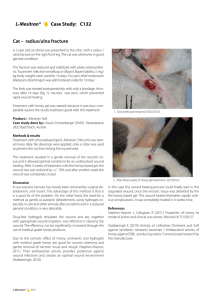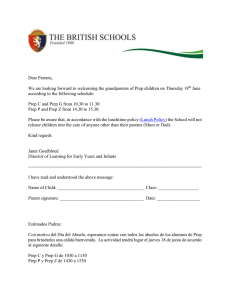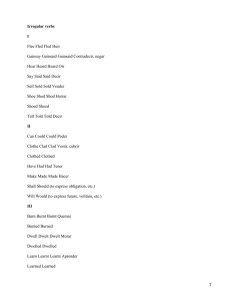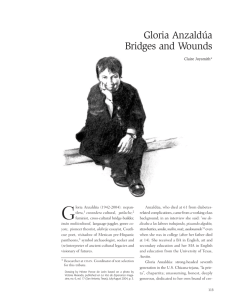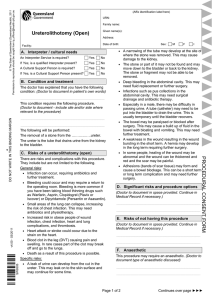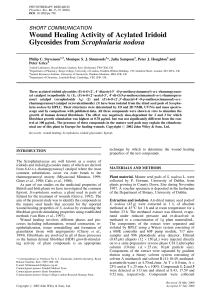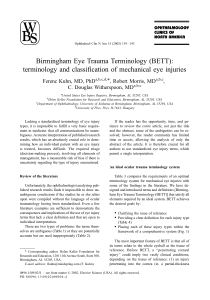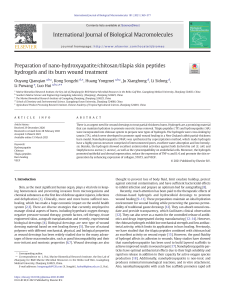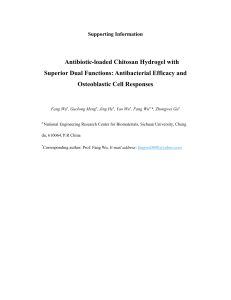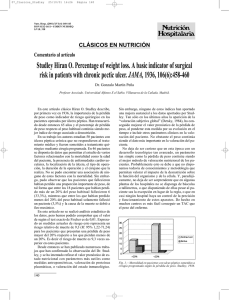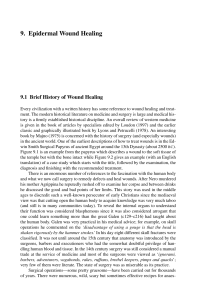Skin and Wound Care Quick Reference/Guideline
Anuncio
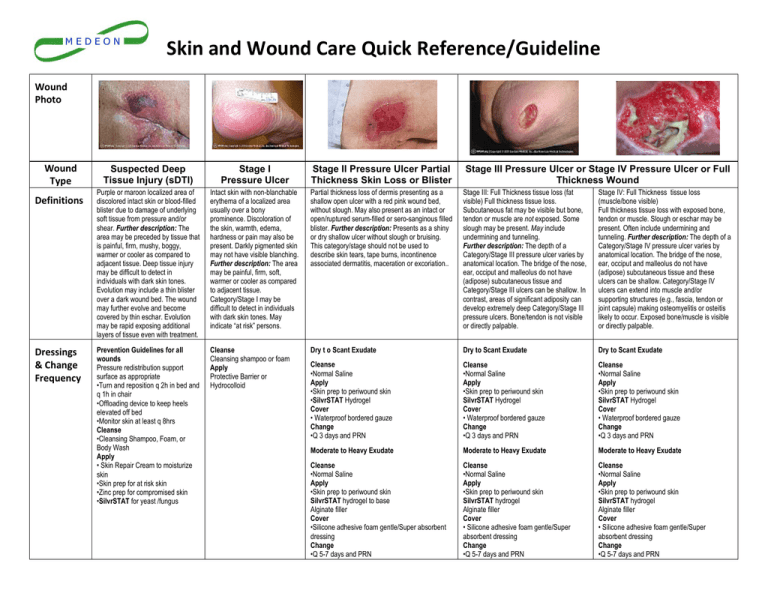
Skin and Wound Care Quick Reference/Guideline Wound Photo Wound Type Definitions Dressings & Change Frequency Suspected Deep Tissue Injury (sDTI) Stage I Pressure Ulcer Stage II Pressure Ulcer Partial Thickness Skin Loss or Blister Stage III Pressure Ulcer or Stage IV Pressure Ulcer or Full Thickness Wound Purple or maroon localized area of discolored intact skin or blood-filled blister due to damage of underlying soft tissue from pressure and/or shear. Further description: The area may be preceded by tissue that is painful, firm, mushy, boggy, warmer or cooler as compared to adjacent tissue. Deep tissue injury may be difficult to detect in individuals with dark skin tones. Evolution may include a thin blister over a dark wound bed. The wound may further evolve and become covered by thin eschar. Evolution may be rapid exposing additional layers of tissue even with treatment. Intact skin with non-blanchable erythema of a localized area usually over a bony prominence. Discoloration of the skin, warmth, edema, hardness or pain may also be present. Darkly pigmented skin may not have visible blanching. Further description: The area may be painful, firm, soft, warmer or cooler as compared to adjacent tissue. Category/Stage I may be difficult to detect in individuals with dark skin tones. May indicate “at risk” persons. Partial thickness loss of dermis presenting as a shallow open ulcer with a red pink wound bed, without slough. May also present as an intact or open/ruptured serum-filled or sero-sanginous filled blister. Further description: Presents as a shiny or dry shallow ulcer without slough or bruising. This category/stage should not be used to describe skin tears, tape burns, incontinence associated dermatitis, maceration or excoriation.. Stage III: Full Thickness tissue loss (fat visible) Full thickness tissue loss. Subcutaneous fat may be visible but bone, tendon or muscle are not exposed. Some slough may be present. May include undermining and tunneling. Further description: The depth of a Category/Stage III pressure ulcer varies by anatomical location. The bridge of the nose, ear, occiput and malleolus do not have (adipose) subcutaneous tissue and Category/Stage III ulcers can be shallow. In contrast, areas of significant adiposity can develop extremely deep Category/Stage III pressure ulcers. Bone/tendon is not visible or directly palpable. Stage IV: Full Thickness tissue loss (muscle/bone visible) Full thickness tissue loss with exposed bone, tendon or muscle. Slough or eschar may be present. Often include undermining and tunneling. Further description: The depth of a Category/Stage IV pressure ulcer varies by anatomical location. The bridge of the nose, ear, occiput and malleolus do not have (adipose) subcutaneous tissue and these ulcers can be shallow. Category/Stage IV ulcers can extend into muscle and/or supporting structures (e.g., fascia, tendon or joint capsule) making osteomyelitis or osteitis likely to occur. Exposed bone/muscle is visible or directly palpable. Prevention Guidelines for all wounds Pressure redistribution support surface as appropriate •Turn and reposition q 2h in bed and q 1h in chair •Offloading device to keep heels elevated off bed •Monitor skin at least q 8hrs Cleanse •Cleansing Shampoo, Foam, or Body Wash Apply • Skin Repair Cream to moisturize skin •Skin prep for at risk skin •Zinc prep for compromised skin •SilvrSTAT for yeast /fungus Cleanse Cleansing shampoo or foam Apply Protective Barrier or Hydrocolloid Dry t o Scant Exudate Dry to Scant Exudate Dry to Scant Exudate Cleanse •Normal Saline Apply •Skin prep to periwound skin •SilvrSTAT Hydrogel Cover • Waterproof bordered gauze Change •Q 3 days and PRN Cleanse •Normal Saline Apply •Skin prep to periwound skin SilvrSTAT Hydrogel Cover • Waterproof bordered gauze Change •Q 3 days and PRN Cleanse •Normal Saline Apply •Skin prep to periwound skin SilvrSTAT Hydrogel Cover • Waterproof bordered gauze Change •Q 3 days and PRN Moderate to Heavy Exudate Moderate to Heavy Exudate Moderate to Heavy Exudate Cleanse •Normal Saline Apply •Skin prep to periwound skin SilvrSTAT hydrogel to base Alginate filler Cover •Silicone adhesive foam gentle/Super absorbent dressing Change •Q 5-7 days and PRN Cleanse •Normal Saline Apply •Skin prep to periwound skin SilvrSTAT hydrogel Alginate filler Cover • Silicone adhesive foam gentle/Super absorbent dressing Change •Q 5-7 days and PRN Cleanse •Normal Saline Apply •Skin prep to periwound skin SilvrSTAT hydrogel Alginate filler Cover • Silicone adhesive foam gentle/Super absorbent dressing Change •Q 5-7 days and PRN Skin and Wound Care Quick Reference/Guideline Wound Photo Wound Type Definitions Unstageable Pressure Ulcers Necrotic Wounds Unstageable –Full thickness tissue loss in which actual depth of the ulcer is completely obscured by slough (yellow, tan, gray, green or brown) and/or eschar (tan, brown or black) in the wound bed. Further description: Until enough slough and/or eschar are removed to expose the base of the wound, the true depth cannot be determined; but it will be either a Category/Stage III or IV. Stable (dry, adherent, intact without erythema or fluctuance) eschar on the heels serves as “the body’s natural (biological) cover” and should not be removed. Solid Dry Eschar on Heels Dressings & Change Frequency Cover •No Dressing •Keep Dry FLOAT HEELS TO RELIEVE PRESSURE Skin Tear Category I or II Category I: A skin tear without tissue loss. Characteristics are based on whether the damage is a linear tear or a skin-flap type tear. Both tears can be fully approximated. Category II; A skin tear with partial tissue loss. Tears will have a partial thickness epidermal tissue loss. The tears are further classified as scant versus moderate to large tissue loss. Skin Tear Category III Colonized or Infected Wounds Category III: A skin tear with complete tissue loss where the epidermal flap is absent. These are wounds with complete tissue loss Colonized : Bacterial load is high enough that the host is losing control over wound environment – may not show critical signs of infection. Cleanse •Normal Saline Apply •Skin prep to periwound skin SilvrSTAT Hydrogel over wound Cover • Silicone adhesive foam gentle/Super absorbent dressing Change •Q 5-7 days and PRN Cleanse •Normal Saline Apply •Skin prep to periwound skin •SilvrSTAT Hydrogel Cover •Dry to Scant Waterproof bordered gauze Moderate to Heavy Drainage Calcium Alginate cover dressing Change •Q 3 -5 days and PRN Infected: Represents the invasion of bacteria into healthy tissue where they continue to proliferate and elicit a reaction from the host – will typically show signs of clinical infection. Other Necrotic Wounds with Eschar or Yellow or Black Slough Cleanse • Wound Cleanser Apply •Skin prep to periwound skin Sharp debridement if possible if not then use enzymatic debrider for 4 -5 days then use SilvrSTAT Hydrogel Cover •Waterproof bordered gauze Change •Q 3-7 days and PRN Approximate edges when possible with moistened swab Cleanse •Normal Saline Apply •Skin prep to periwound skin •SilvrSTAT Hydrogel Cover •Gauze/Rolled Gauze Change •Q 3 days and PRN Questions? Email - [email protected]
